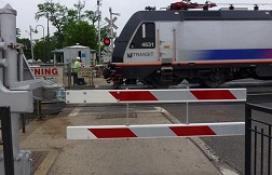New Report: Effect of Gate Skirts on Pedestrian Behavior at Highway-Rail Grade Crossings
The Federal Railroad Administration (FRA) tasked Volpe with assisting in the evaluation of one type of pedestrian safety device, commonly known as a gate skirt, that consists of a secondary horizontal hanging gate under the existing pedestrian gate to better block access to the crossing by pedestrians who gain unauthorized entry by going under the down gates. As part of this effort, Volpe participated in a New Jersey Transit rail pilot project to evaluate a prototype design installed at a grade crossing in Matawan, NJ, on May 30, 2012.
The purpose of this evaluation was to determine if the addition of gate skirting would result in fewer pedestrians attempting to violate the crossing on the sidewalk after the gates began to descend. Data were collected over a 2-week period before and a 2-week period after the installation of the gate skirts. Pedestrian actions were coded during all train activations that occurred during this 4-week period.
The research team found that the total number of pedestrian violations decreased while the gates were descending (78 percent reduction) and horizontal (55 percent reduction), but increased while the gates were ascending (12 percent increase). Additionally, after the installation of the gate skirts, more pedestrians who violated while the gates were descending or horizontal chose to do so in the adjacent street where there were no gate skirts, as opposed to on the sidewalk where the safety enhancement had been added.
This report was prepared for the Federal Railroad Administration by Volpe authors Stephanie Chase, Scott H. Gabree, and Marco daSilva.
Report: Effect of Gate Skirts on Pedestrian Behavior at a Highway-Rail Grade Crossing.
This is a featured report of the Volpe Library. To see our full collection of reports, journal articles, and conference presentations and papers, please visit the Library search page.

